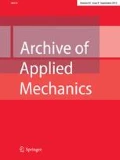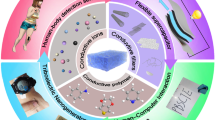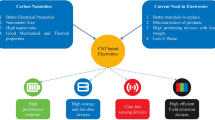Abstract
Deformation of thin elastic sheet due to electrostatic forces play important role in engineering and biological systems. In this work, we analyze the deformation of thin elastic sheet, while interacting with a rigid curved domain in the presence of dielectric fluid. Mechanical deformation of the sheet is coupled with the electrostatic interaction in its equilibrium configuration. We consider small deformation of the sheet, which obeys Hooke’s law. The electrostatic forces acting between the sheet and curved domain are calculated by using Debye–Hückel equation. It is observed that the sheet deformation is proportional to the electrostatic forces acting on it. Increase in inverse Debye length (which signifies the strength of electrostatic field) of the dielectric fluid decreases the sheet deformation. With the help of present model, binding mechanism between peripheral BAR proteins and cell membrane is studied by treating cell membrane as an elastic membrane and BAR protein as a rigid curved domain. For small curvature of BAR protein, the present model captures very well the scaffolding mechanism of protein binding. This model can also be used to analyze problems in electrophotography, powder technology, semiconductor and pharmaceutical industries.









Similar content being viewed by others
References
Mahata, P., Das, S.L.: Generation of wavy structure on lipid membrane by peripheral proteins: a linear elastic analysis. FEBS Lett. 591, 1333–1348 (2017)
McMahon, H.T., Boucrot, El: Membrane curvature at a glance. J. Cell Sci. 128, 1065–1070 (2015)
Mim, C., Unger, V.M.: Membrane curvature and its generation by BAR proteins. Trends Biochem. Sci. 37(12), 526–533 (2012)
Bassereau, P., Jin, R., Baumgart, T., Deserno, M., Dimova, R., Frolov, V.A., Bashkirov, P.V., Grubmller, H., Jahn, R., Risselada, H.J., Johannes, L., Kozlov, M.M., Lipowsky, R., Pucadyil, T.J., Zeno, W.F., Stachowiak, J.C., Stamou, D., Breuer, A., Lauritsen, L., Simon, C., Sykes, C., Voth, G.A., Weikl, T.R.: The 2018 biomembrane curvature and remodeling roadmap. J. Phys. D Appl. Phys. 51, 343001 (2018)
Kozlov, M.M., Weissenhorn, W., Bassereau, P.: Membrane remodeling: theoretical principles, structures of protein scaffolds and forces involved. From Mol. Living Org. Interplay Between Biol. Phys. Lect. Notes Les Houches Sch. Phys. 102, 287 (2016)
Campelo, F., Kozlov, M.M.: Sensing membrane stresses by protein insertions. PLoS Comput. Biol. 10(4), e1003556 (2014)
Feng, J.Q., Hays, D.A.: Relative importance of electrostatic forces on powder particles. Powder Technol. 135–136, 65–75 (2003)
Schein, L.B.: Electrostatic proximity force, toner adhesion, and a new electrophotographic development system. J. Electrostat. 65, 613–617 (2007)
Vinogradova, O.I., Lebedeva, O.V., Kim, B.-S.: Mechanical behavior and characterization of microcapsules. Annu. Rev. Mater. Res. 36, 143–178 (2006)
Raichur, A., Vörös, J., Textor, M., Fery, A.: Adhesion of polyelectrolyte microcapsules through biotinstreptavidin specific interaction. Biomacromolecules 7, 2331–6 (2006)
Campelo, F., Fabrikant, G., McMahon, H.T., Kozlov, M.M.: Modeling membrane shaping by proteins: focus on EHD2 and N-BAR domains. FEBS Lett. 584(9), 1830–1839 (2010)
Yin, Y., Arkhipov, A., Schulten, K.: Simulations of membrane tubulation by lattices of amphiphysin N-BAR domains. Structure 17(6), 882–892 (2009)
Simunovic, M., Voth, G.A., Callan-Jones, A., Bassereau, P.: When physics takes over: BAR proteins and membrane curvature. Trends Cell Biol. 25(12), 780–792 (2015)
Arkhipov, A., Yin, Y., Schulten, K.: Membrane-bending mechanism of amphiphysin N-BAR domains. Biophys. J. 97, 2727–2735 (2009)
Zhu, C., Das, S.L., Baumgart, T.: Nonlinear sorting, curvature generation, and crowding of endophilin N-BAR on tubular membranes. Biophys. J. 102, 1837–1845 (2012)
Cui, H., Mim, C., Vazquez, F.X., Lyman, E., Unger, V.M., Voth, G.A.: Understanding the role of amphipathic helices in N-BAR domain driven membrane remodeling. Biophys. J. 104(2), 404–411 (2013)
Heinrich, M.C., Capraro, B.R., Tian, A., Isas, J.M., Langen, R., Baumgart, T.: Quantifying membrane curvature generation of drosophila amphiphysin N-BAR domains. J. Phys. Chem. Lett. 1(23), 3401–3406 (2010)
Hutchison, J.B., Mudiyanselage, A.P.K.K.K., Weis, R.M., Dinsmore, A.D.: Osmotically-induced tension and the binding of N-BAR protein to lipid vesicles. Soft Matter 12, 2465–2472 (2016)
Yu, H., Schulten, K.: Membrane sculpting by F-BAR domains studied by molecular dynamics simulations. PLoS Comput. Biol. 9(1), 1–15 (2013)
Wang, Q., Navarro, M.V.A.S., Peng, G., Molinelli, E., Goh, S.L., Judson, B.L., Rajashankar, K.R., Sondermann, H.: Molecular mechanism of membrane constriction and tubulation mediated by the F-BAR protein Pacsin/Syndapin. PNAS 106(31), 12700–12705 (2009)
Kabaso, D., Gongadze, E., Elter, P., van Rienen, U., Gimsa, J., Kralj-Iglic, V., Iglic, A.: Attachment of rod-like (BAR) proteins and membrane shape. Mini-Rev. Med. Chem. 11, 272–282 (2011)
Golestaneh, A.F., Nadler, B.: Modeling of cell adhesion and deformation mediated by receptor-ligand interactions. Biomech. Model. Mechanobiol. 15(2), 371–387 (2016)
Liu, T., Singh, P., Jenkins, J.T., Jagota, A., Bykhovskaia, M., Hui, C.: A continuum model of docking of synaptic vesicle to plasma membrane. J. R. Soc. Interface 12(102), 20141119 (2015)
Sohail, T., Tang, T., Nadler, B.: Adhesive contact of a fluid-filled membrane driven by electrostatic forces. Int. J. Solids Struct. 50, 2678–2690 (2013)
Patil, A., Nordmark, A., Eriksson, A.: Instability investigation on fluid-loaded pre-stretched cylindrical membranes. Proc. R. Soc. A 471, 20150016 (2015)
Wang, X., Yin, L., Yang, Q.: Numerical analysis of the wrinkling behavior of thin membranes. Arch. Appl. Mech. 89, 2361–2380 (2019)
Steigmann, D., Agrawal, A.: Electromechanics of polarized lipid bilayers. Math. Mech. Complex Syst. 4(1), 31–54 (2016)
Das, S., Thaokar, R.M.: Large deformation electrohydrodynamics of an elastic capsule in DC electric field. J. Fluid Mech. 841, 489–520 (2018)
Das, S., Deshmukh, S.D., Thaokar, R.M.: Deformation of a biconcave-discoid capsule in extensional flow and electric field. J. Fluid Mech. 860, 115–144 (2018)
Das, S., Thaokar, R.M.: Large deformation electrohydrodynamics of a Skalak elastic capsule in AC electric field. Soft Matter 14(9), 1719–1736 (2018)
Sinha, K.P., Thaokar, R.M.: Electrohydrodynamics of a compound vesicle under an AC electric field. J. Phys.: Condens. Matter 29(27), 275101 (2017)
Sinha, K.P., Thaokar, R.M.: Effect of AC electric field on the dynamics of a vesicle under shear flow in the small deformation regime. Phys. Rev. E 97, 032404 (2018)
Sreeja, K.K., Sunil Kumar, P.B.: Lipid-protein interaction induced domains: kinetics and conformational changes in multicomponent vesicles. J. Chem. Phys. 148, 134703 (2018)
Olinger, A.D., Spangler, E.J., Sunil Kumar, P.B., Laradji, M.: Membrane-mediated aggregation of anisotropically curved nanoparticles. Faraday Discuss 186, 265–275 (2016)
Spencer, A.J.M.: Continuum Mechanics, 1st edn. Dover Publications Inc., Mineola, New York (2004)
Campelo, F., McMahon, H.T., Kozlov, M.M.: The hydrophobic insertion mechanism of membrane curvature generation by proteins. Biophys. J. 95(5), 2325–2339 (2008)
Campelo, F., Kozlov, M.M.: Sensing membrane stresses by protein insertions. PLoS Comput. Biol. 10(4), e1003556 (2014)
Donath, E., Budde, A., Knippel, E., Baumler, H.: Hairy surface layer: concept of electrophoresis combined with local fixed surface charge density isothems: application to human erythrocyte electrophoretic fingerprinting. Langmuir 12, 4832–4839 (1996)
Dill, K.A., Bromberg, S.: Molecular Driving Forces: Statistical Thermodynamics in Biology, Chemistry, Physics, and Nanoscience. Garland Science, New York (2010)
Birdi, K.S.: Surface and Colloid Chemistry. CRC Press, Boca Raton (1997)
Jadidi, T., Seyyed-Allaei, H., Tabar, M.R.R., Mashaghi, A.: Poissons ratio andyoungs modulus of lipid bilayers in different phases. Front. Bioeng. Biotechnol. 2, 1–6 (2014)
Lipowsky, R., Sackmann, E.: Structure and Dynamics of Membranes. Handbook of Biological Physics, vol. 1A. Elsevier, New York (1995)
Israelachvili, J.N., Mitchell, D.J., Ninham, B.W.: Theory of self-assembly of hydrocarbon amphiphiles into micelles and bilayers. J. Chem. Soc. Faraday Trans. 2(72), 1525–1568 (1976)
McMahon, H.T., Gallop, J.L.: Membrane curvature and mechanisms of dynamic cell membrane remodelling. Nature 438(7068), 590–596 (2005)
Baumgart, T., Capraro, B.R., Zhu, C., Das, S.L.: Thermodynamics and mechanics of membrane curvature generation and sensing by proteins and lipids. Annu. Rev. Phys. Chem. 62, 483–506 (2011)
Smith, A.M., Lee, A.A., Perkin, S.: The electrostatic screening length in concentrated electrolytes increases with concentration. J. Phys. Chem. Lett. 7, 2157–2163 (2016)
Gallop, J.L., Jao, C.C., Kent, H.M., Butler, P.J.G., Evans, P.R., Langen, R., McMahon, H.T.: Mechanism of endophilin N-BAR domain-mediated membrane curvature. EMBO J. 303, 2898–2910 (2006)
Gallop, J.L., McMahon, H.T.: BAR domains and membrane curvature: bringing your curves to the BAR. Biochem. Soc. Symp. 72, 223–231 (2005)
Weissenhorn, W.: Crystal structure of the endophilin-A1 BAR domain. J. Mol. Biol. 351(3), 653–661 (2005)
Acknowledgements
P. Mahata acknowledges Dr. Raju Poddar (Department of Bioengineering, BIT Mesra), Dr. Susanta Sinha Mahapatra (Department of Chemistry, BIT Mesra), and Dr. Anup Basak (Department of Mechanical Engineering, IIT Tirupati) for the discussions regarding structural dimensions of proteins, properties of di-electric fluid, and boundary conditions of the membrane sheet. The authors would also like to thank the anonymous referee for pointing out the issue about the boundary conditions.
Author information
Authors and Affiliations
Corresponding author
Ethics declarations
Conflict of interest
On behalf of all authors, the corresponding author states that there is no conflict of interest.
Additional information
Publisher's Note
Springer Nature remains neutral with regard to jurisdictional claims in published maps and institutional affiliations.
Appendices
Appendix A: Variation of attractive and repulsive forces
The attractive and repulsive forces in z-direction are calculated numerically using Eqs. (33) and (29), respectively. The absolute value of attractive force is maximum near to the pinned support (\(\bar{X} = \pm b/2\)) of the membrane as shown in Fig. 10. The values of the repulsive forces are close to zero along the width of the membrane.
Variation of attractive (\(\bar{f}_{az}\)) and repulsive (\(\bar{f}_{rz}\)) force acting in z-direction of membrane at \(\bar{Y} = 0.5\) for \(\bar{\sigma }_c = 1\) with \(\bar{b} = 0.3\). Other parameter values are \(\bar{H} = 0.01\), \(\theta = \pi \), \(\bar{k} = 1\), \(\bar{R} = 0.15\), \(\bar{t} = 0.04\), and \(\bar{\mu } = 644\)
Appendix B: Variation of traction associated with the membrane tensions
The tractions associated with the membrane tensions \(\bar{p}_x\) and \(\bar{p}_y\) are calculated using Equilibrium Eqs. (38) and (39), respectively. The total electrostatic traction \(\bar{f}_{ex}\) and \(\bar{f}_{ey}\) are obtained from Eqs. (35) and (36), respectively, after calculating integrals \(\bar{f}_{ax}\), \(\bar{f}_{ay}\), \(\bar{f}_{rx}\), and \(\bar{f}_{ry}\) numerically from Eqs. (31)–(32) and (27)–(28). It is observed that the traction \(\bar{p}_x\) does not have significant changes as we approach along the length of the membrane as shown in Fig. 11a.
Variation of traction associated with the membrane tension in a x and b y directions for different values of \(\bar{Y}\). The tractions are depicted in \(x-z\) plane. The parameter values are \(\bar{H} = 0.01\), \(\theta = \pi \), \(\bar{k} = 1\), \(\bar{R} = 0.15\), \(\bar{t} = 0.04\), and \(\bar{\sigma }_c = 1\)
If we do not consider the edge effect of the membrane near \(\bar{Y} = 0\) and 1, then the traction \(\bar{p}_y\) will have almost constant value along the width of the membrane as shown in Fig. 11b. It is more prominent near to the middle of the length of the membrane (i.e., at \(\bar{Y} = 0.5\)). The value of \(\bar{p}_y\) approaches zero near to the middle. It will be equal to zero at \(\bar{Y} = 0.5\) because of symmetry (not shown in figure). As we approach toward the edges of the membrane, the value of \(\bar{p}_y\) increases to maintain the deformation of membrane only in z-direction. Here, negative value of the traction component signifies the opposite nature of it.
Rights and permissions
About this article
Cite this article
Mahata, P., Vennamneni, L. Deformation of an elastic membrane interacting electrostatically with a rigid curved domain: implications to biosystems. Arch Appl Mech 91, 509–525 (2021). https://doi.org/10.1007/s00419-020-01785-1
Received:
Accepted:
Published:
Issue Date:
DOI: https://doi.org/10.1007/s00419-020-01785-1






